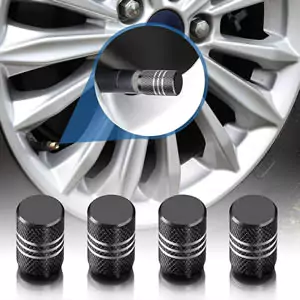Tire Valve Cap
A tire valve cap is a small cover that screws onto the stem of a tire's air valve. It is the last defense against air escaping from your tires and prevents dirt, dust, and moisture from damaging the valve core, which can lead to air loss. Tire valve caps may seem like inconsequential components of a vehicle's wheel, but they play a crucial role in maintaining tire pressure, protecting the valve from dirt and moisture, and potentially saving fuel. Understanding the different types of tire valve caps, their importance, factors to consider when choosing one, and how to use them correctly can contribute significantly to vehicle maintenance and safety.
Types of Tire Valve Caps
There are several types of tire valve caps available, each with its unique features and benefits:
- Plastic Caps: These are the most common and cost-effective option. They provide basic protection against dirt and moisture.
- Metal Caps: Made from aluminum or stainless steel, metal caps are more durable than plastic ones and offer a better seal. Some come with rubber seals for enhanced performance.
- LED Caps: These caps include small LED lights that illuminate when the wheel is in motion, increasing visibility and safety at night. They are more about aesthetics and safety through visibility rather than improved functionality.
- Pressure Indicator Caps: These caps change color or provide a visual indicator when tire pressure drops below a safe level, offering a quick way to check if your tires need air.

Importance of Tire Valve Caps
The primary importance of tire valve caps includes:
- Preventing Air Loss: Even though the valve stem itself is designed to keep air in, the cap provides an additional seal against leaks, ensuring that your tire remains properly inflated for longer.
- Protecting the Valve: Caps keep out contaminants that can corrode or damage the valve stem, potentially leading to leaks or problems when adding or releasing air.
- Safety: Properly inflated tires provide optimal performance. By helping to maintain the correct tire pressure, valve caps contribute to safer driving conditions.
- Fuel Efficiency: Correct tire pressure is essential for fuel efficiency. Under-inflated tires can increase fuel consumption, so by keeping your tires inflated properly, valve caps indirectly help save on fuel costs.
Choosing the Right Tire Valve Cap
When selecting tire valve caps, consider the following factors:
- Material: Choose a material that suits your climate and driving conditions. Metal caps are better for harsh conditions, while plastic caps might suffice for mild climates.
- Features: If tire pressure monitoring is important to you, consider caps with pressure indicators. For enhanced safety and visibility, LED caps might be the right choice.
- Compatibility: Ensure the caps you choose are compatible with your vehicle's tire valve stems. Most are universal, but there are exceptions.
- Quality: Opt for high-quality caps that provide a good seal and durable construction to withstand the elements and road conditions.
Buy quality tire valve caps on Amazon and eBay.
How to Use Tire Valve Caps
Using tire valve caps correctly is straightforward:
- Check Tire Pressure: Before installing the cap, ensure your tire pressure is at the recommended level.
- Clean the Valve Stem: Remove any dirt or debris from the valve stem to ensure a clean contact surface.
- Screw on the Cap: Place the cap over the valve stem and screw it on clockwise until it's snug. Do not over-tighten, as this can damage the cap or valve stem.
- Regular Checks: Regularly check your tire pressure and inspect the caps for damage. Replace caps that are cracked, damaged, or missing.
Tire valve caps play a crucial role in vehicle maintenance and safety. By choosing the right type of cap and using it correctly, you can protect your tire valves, maintain proper tire pressure, and ensure a safer driving experience. Always remember, something as simple as a tire valve cap can have a significant impact on your vehicle's performance and efficiency.
All listed guides, data and/or calculations are for informational purposes only. TirePressure.com does not warrant or make any representations regarding the accuracy of or the results of the use of this information.